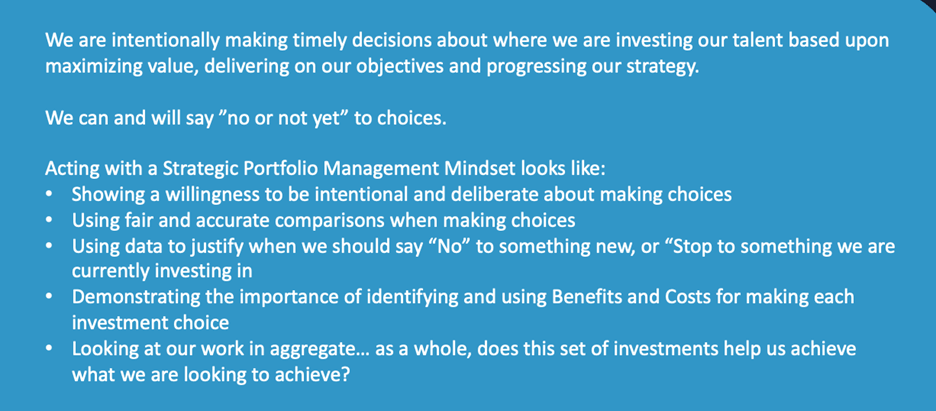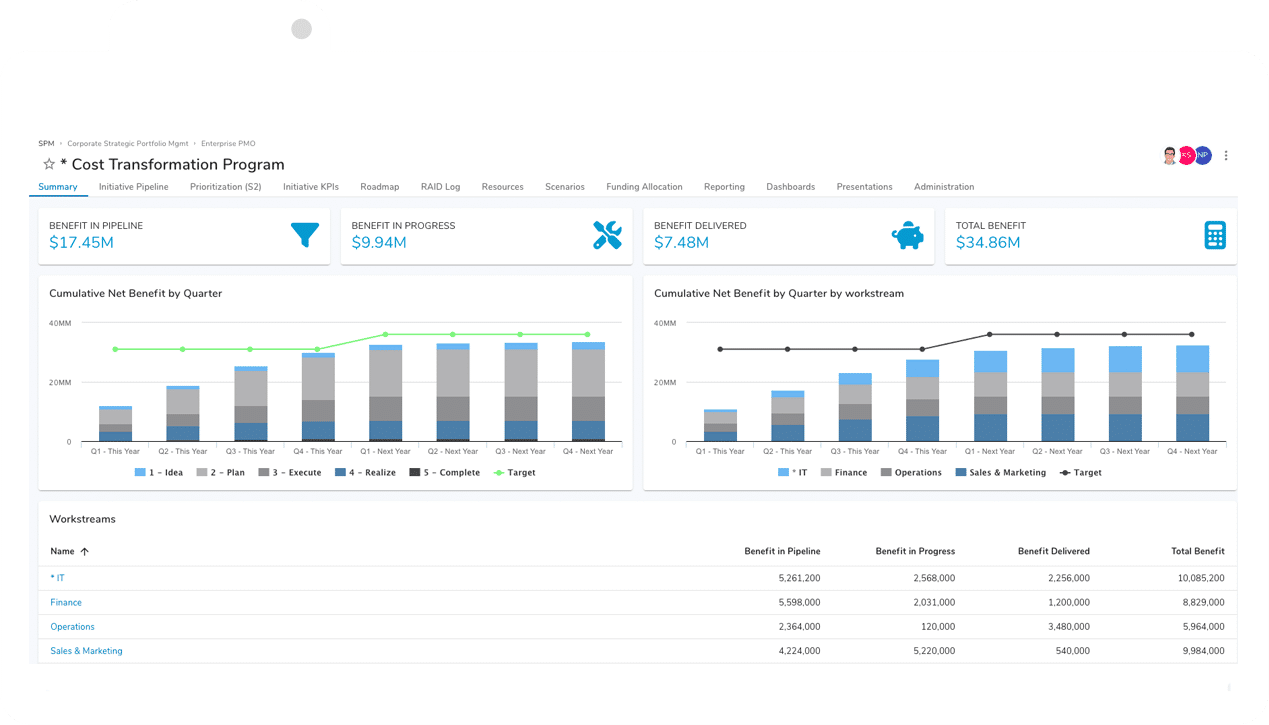Picture this. It is January 3rd and you’ve just returned to work after a long, relaxing vacation. As you step into your office and envision the upcoming weeks, your shoulders start to tense.
Several months ago, your company announced that it needs to move in a new direction. The executive leadership team has set some ambitious transformation goals for the organization to achieve in the next several years. You’re the leader of a recently formed PMO (or EMPO, Transformation Office or Strategy Realization Office), and you’ve been tasked with guiding your organization through this period of transition and must organize and oversee a set of programs designed to meet certain transformation objectives.
In the coming months, you and your small (but mighty) team will need to develop new initiatives aligned to the transformation goals, decide how to guide/support those initiatives, help people deploy new technology and/or engage in business process re-engineering as needed, and drive the necessary cultural shifts so the business can achieve its overall transformation objectives. Your executives are also expecting monthly updates on the progress of this transformation effort.
Understanding Strategic Portfolio Management
To set yourself, your PMO, and your company up for success, you know that old mindsets, processes, and practices must change. For instance:
- Your organization needs much better visibility into your full portfolio – so that leaders can evaluate new programs/projects not in isolation, but in the context of how they align with and support the overall objectives of the organization.
- Leaders often rely on intuition and their personal experience when making decisions. You would like organizational leaders to be more deliberate and more data-driven when deciding what programs and projects to execute and what to say “no” to.
- You wish leaders had the courage to say “no” more often to projects that don’t add enough value and use data to justify their decisions.
- Complex initiatives often stalled in the middle because teams were operating in silos. You’d like the teams working on cross-functional initiatives to get a better understanding of how where interdependencies exist early, make agreements to manage interdependencies and meet their commitments to one another.
- Budgets and staffing for initiatives and projects are determined up front and don’t shift as an initiative gets underway. You believe that resources should shift more fluidly from one project to another to optimize for the value delivered in total.
In short, you’d like your organization to start operating with a strategic portfolio management mindset and develop stronger strategic portfolio management capability to navigate the choppy waters of transformation more effectively.
Yet, there’s some challenges you must address: most people in your organization aren’t familiar with strategic portfolio management as a discipline. They’ve not yet recognized a need to change.
What steps can you take to gain broad-based support for the work you’re trying to do? How can you make the value of portfolio management so obvious to everyone – so that not only do you get the resources (tools, staff) you need, but people start following your guidance willingly and enthusiastically?
In this article, we’ll share the winning practices highly successful PMO and EPMO leaders have implemented to secure the resources their team needs and to shift culture forward (so that SPM becomes core to how their organizations operate).
Implementing Strategic Portfolio Management: Key Steps to Take

1. Define what operating with a strategic portfolio management mindset looks like
To gain broad support for your team’s work, start by giving everyone a clear picture of the desired destination. In this case, the destination is that your organization behaves and operates differently than before, in a way that’s more conducive achieving the business outcomes leaders care about.
One clever Strategy Realization Office leader (a Shibumi customer) decided that they wanted to get everyone in their organization “on the same page”. They wrote a definition for strategic portfolio management (SPM) and clarified what operating with an SPM mindset looks like.

Take a moment and observe whether any section of this definition resonates with you. What would you include in your version?
If you haven’t already done so, it is worth your time to do this type of exercise with your key stakeholders.
2. Define Your Portfolio Management Priorities
When we say portfolio management priorities, we’re referring to the specific capabilities your PMO (or Transformation Office) has to offer that will add significant value to your organization.
For instance, the same Strategy Realization Office that provided the definition above has defined the following items as the key priorities of this office:
- Transparency of the full portfolio to decision makers and stakeholders
- Value-based prioritization and decision-making
- Dependency alignment and Management
- Creating a balanced portfolio across several lenses (i.e., long-term/short-term, strategic/tactical, run/grow/transform)
Further, they’ve stated that portfolio management is not a separate discipline but a part of their operating model. Their portfolio management meetings are embedded into existing leadership meetings.
Defining the priorities for your transformation office and sharing them with leadership is a key step to gaining supporters. When you know what your priorities are (and leadership agree), it’s easy to figure out processes ought to be incorporated into your operations, spot capabilities gaps, and articulate to the purse-string holder why you need certain resources (i.e., software, staff) to fulfill your mission.
3. Assess Your Current Strategic Portfolio Management Capabilities and Identify Gaps

It can be helpful to think about strategic portfolio management as an organizational capability that helps your company gain an advantage. For instance, if your organization can now launch a new product 6 month faster than before because everyone has the data that they need to make decisions faster along the product development lifecycle, that can translate into additional millions of sales per year.
Here at Shibumi, organizations often come to us to learn about our software when they realize that they have some gaps in their portfolio management capabilities and the cost of inaction is just too great.
Below is a list of common challenges PMOs and Transformation Offices face and seek to address:
| Priority Areas | Common Challenges Experienced |
| Transparency of the Full Portfolio to Decision-makers |
|
| Value-Based Prioritization & Resource Allocation |
|
| Communication & Collaboration |
|
| Reporting & Measuring Value |
|
| Stakeholder adoption of a central SPM tool |
|
4. Research Software Options and Understand Its Benefits
Savvy transformation office leaders take the time to shore up their capability gaps by deploying new tools that improve how their organization operates.
SPM software has been a category in the Gartner Magic Quadrant for three years now. This type of software can make implementation of the SPM approach much easier while helping your strategic project management office get work done as efficiently and effectively as possible.
For instance, Shibumi is purpose-built to help PMOs and Transformation Offices do their best work and deliver more business value to their organization. It comes with capabilities to support PMOs’ work in four ways:
- Shibumi serves as a single source of truth, giving stakeholders visibility into the full portfolio. This serves as the foundation for making better investment decisions and governing a portfolio.
- Shibumi enables PMOs and business leaders to make value-based prioritization and resource allocation decisions. It empowers people to use data on Benefits and Costs to prioritize and decide which initiatives/projects to start or stop, what work items can be delayed or cut, and allocate resources (people, budget) to work that’s strategically aligned and valuable to the business.
- Shibumi improves communication and collaboration between teams. Project/program leaders can map out their plans; everyone can understand dependencies between projects and manage those effectively – so the organization can achieve the benefit from projects in the timeframe people had agreed to.
- Shibumi automates value-based reporting. When everyone uses Shibumi to track key initiatives and their milestones, reports are become an automated by-product of using the software. Shibumi provides out-of-the-box and configurable reports for all types of stakeholders involved in a transformation program – so everyone can make better, faster, data-driven decisions in their own domain – which ultimately fuels success at the enterprise level.
You can visit our Product page to learn more about Shibumi.

While we’re proud of Shibumi and confident that it’s a valuable tool for many transformation offices, the right tool is always one that fits into your culture and can be embraced by your leaders and staff. Thus, as you start your software evaluation process, be sure to take some time to understand your organizational culture, identify key people who will use the software, understand their frustrations with current tools and their expectations for the new tool.
Further, remember that none of us has much time to learn a new tool. It’s beneficial to take some time to click through and understand the functionality for yourself – so you grasp the level of effort required for someone to learn to use this software.
5. Include Key Stakeholders in the Software Evaluation Process
Lastly, savvy transformation office leaders are inclusive. As they start to evaluate software options, they consider who else they should invite (e.g., an executive sponsor, a project manager, a department head, etc.) into the process – so people feel heard, validated – and can also become advocates and change agents.
Parting Thoughts
By reading this, we hope you’ve gained some insights in how to effectively build support for your transformation office’s mission and socialize the value of SPM. With leaders and key stakeholders adopting an SPM mindset and approach, you’ll have an easier time governing and managing those complex initiatives and projects. You won’t just be ticking off your immediate goals. You’ll also be setting your organization for long-term success.

